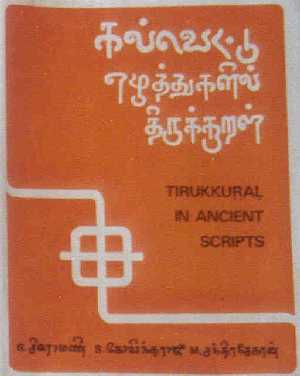

Home | Biodata | Biography | Photo Gallery | Publications | Tributes
Epigraphy

 |

Home | Biodata | Biography | Photo Gallery | Publications | Tributes Epigraphy |
 |
The earliest known inscriptions in Tamil language are written in a script which closely resembles the Brahmi script of the Asokan period and these inscriptions are commonly referred to as Tamil-Brahmi inscriptions. Many of these are placed in the second or third century B.C. on the basis of the style of writing or paleography.
Tamil-Brahmi writings have also been found on Roman pottery belonging to the first century B.C. to the first century A.D. as well as locally manufactured pottery of the same period. These inscriptions have been found in Kanchipuram in the north to Tirunelveli in the south and Karur in the west.
So far only about eighty inscriptions have been reported from about twenty-five sites. Most of these inscriptions were discovered about seventy years ago when they could not be properly deciphered. Only in the 1960's were they satisfactorily deciphered.
Since these are the only records of writing in Tamil in the early period, each inscription is important. We learn not only about the people of that period but also about the evolution of the script. Epigraphists are agreed that the modern Tamil script evolved from Brahmi. In fact, the origin of every modern Indian script can be traced back to the Brahmi script.
Are there other Tamil-Brahmi inscriptions yet to be discovered? Can a layman join the search and succeed? The answer is "Yes", as shown by a group of students of a Madurai college who have brought to light yet another new inscription. The same group led by Mr. E. Jebarajan brought to light the occurrence of a "pulli" in the Anaimalai inscription ("Sunday Standard", February 19. 1978), as well as a new inscription from Vikramangalam, near Madurai ("Sunday Standard", August 13 1978).
On a small hillock called Sinna Undaangallu, near Vikramangalam, about 25 km northwest of Madurai, there is a small cave facing it, three or four metres above the ground. The cave is about 31 metres deep and about one metre wide and one person can lie down in it. The smooth surface used as a bed is not parallel to the mouth of the cave but perpendicular to it. Three short drip lines have been cut to keep the rain water away from the cave.
Below the topmost line is a Tamil-Brahmi inscription hitherto unnoticed by scholars. The tentative reading is.

One can recognize the ''ur" without any difficulty. In
"Pre-Pallavan Tamil Index" a place called Vemperrur is identified with
Kulasekara Chathurvedi Mangalam situated north-west of Madurai. We can, therefore, identify the first portion of the inscription with the village
Vempirrur, probably an earlier name of Vemperrur. Now there are many villages called Vemparrur in Tamil Nadu.
In Sangam literature, there are references to two poets  Vemparrur Kannan Koothanaar and Vemparrur
Kumaranaar
Vemparrur Kannan Koothanaar and Vemparrur
Kumaranaar  hailing from Vemparrur. The portion "pirrur" may refer to the village being a suburb.
hailing from Vemparrur. The portion "pirrur" may refer to the village being a suburb.
One may identify the next portion as the word "Per Ay", or great leader, "Per Ayam" big reservoir, or "Per Aayam" committee. The last portion can be read "Ce(Y) tavar", though the letter "Y" is missing. Then the inscription would mean that the committee of Vemparrur made a donation.
Other scholars may identify the letters differently. The letter "R" in "Vembarrur" may be read as RAI, changing the reading to "Vembiraiyur". The last two letters may be read as TAA NA denoting a donation.
The inscription was brought to the notice of the author by Mr.Jebarajan.